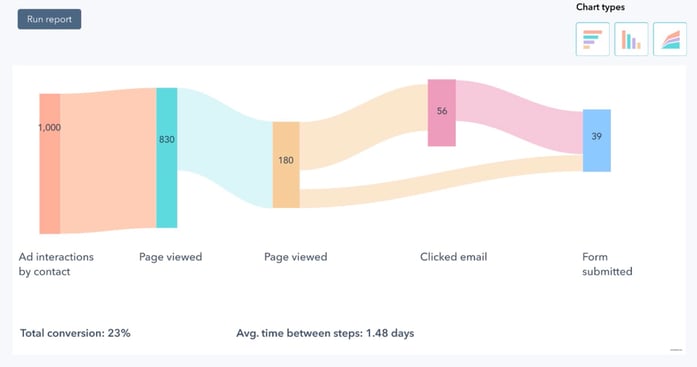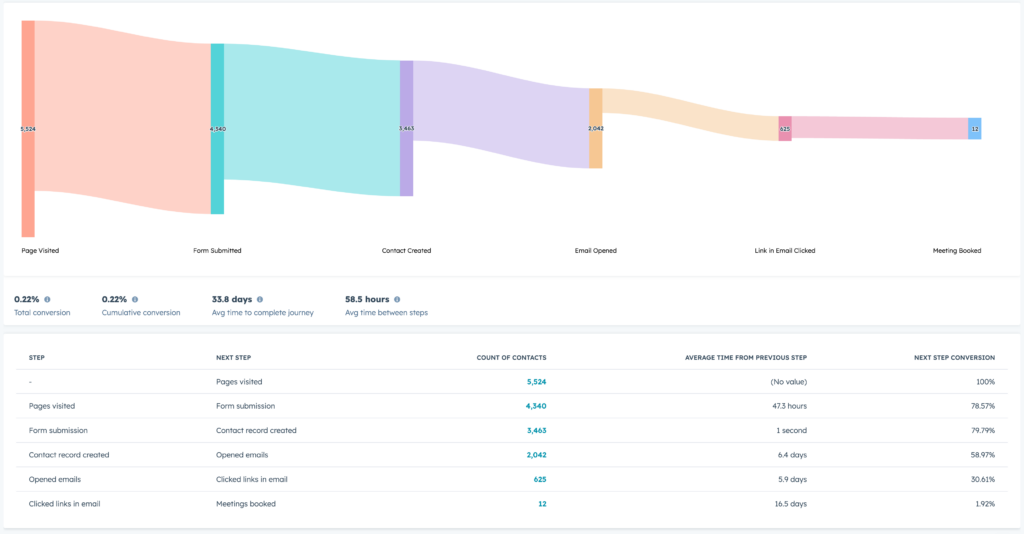Most companies measure the success of their marketing efforts by how prospects move through the funnel. But between awareness and a signed deal, prospects take several more actions that move them from one stage in their journey to the next.
Actions like:
- Visiting a link
- Downloading a resource
- Signing up for a newsletter
- Requesting a demo
Until now, it was hard to determine which touchpoints are most effective at moving customers along without using multiple tools or jumping between platforms. But that changed when HubSpot introduced its new Customer Journey Analytics tool.
HubSpot’s Customer Journey Analytics at a glance
Launched at HubSpot’s Inbound22 conference, Customer Journey Analytics is available to Marketing Hub Enterprise users. It allows marketing and sales teams to see their customer’s end-to-end journey within HubSpot. For example, you can:
- Track customer interactions across all channels, including website visits, email, social media, and phone calls.
- Identify critical touchpoints in the customer journey, such as website visits, blog posts, and email campaigns.
- Measure the impact of each touchpoint on customer engagement and conversion.

Related reading: See HubSpot’s step-by-step walkthrough
3 game-changing insights with Customer Journey Analytics
We’re not ones to brag, but we’ve been certified HubSpot partners since 2015 and achieved HubSpot’s Diamond Solutions Status in 2022. That means our team has a variety of certifications and specializations from HubSpot, and we’re early adopters of HubSpot’s new features.
Recently we sat down with two members of our team: Mary Murphy, Lake One’s resident HubSpot Operations Specialist, and Mark Boyt, one of our Solutions Engineers. Following is their take on how HubSpot’s new customer journey insights change the game for marketing and sales teams.
“This new capability helps us answer far more questions for Lake One’s customers. Previously, we could only see where their prospects were along a basic sales funnel. Now, we know where their prospects stand along the journey they created for specific marketing campaigns.” – Mark Boyt, Solutions Engineer
Insight #1: How prospects are entering your ecosystem based on the funnel you create
You can have multiple marketing campaigns live across various channels using similar or even identical content at any given time. But that data isn’t helpful if you don’t know what touchpoint resulted in prospects landing in your database.
You can use Customer Journey Analytics to track how many customers come to your website from different sources, such as organic search, paid advertising, or social media. Want to go deeper? You can drill down further into your source data to track specific campaigns or ads.
And just like that – you know far more about your traffic and sources based on the specific funnel that you created (and not just the standard MQL > SQL > opportunity > customer).
Insight #2: How prospects are moving from point A to point B
Now that you have a prospect in your database, you want visibility into what’s moving them along in their journey. For example, say you design a multi-part nurture campaign that encourages prospects to download your new white paper.
- Before customer journey reporting: you’d only be able to see the end result (i.e., how many people completed the form). You’d have to manually look at each email within your campaign to find out what led them to download your white paper.
- With customer journey reporting: you can break down interactions in the forms submission view and see precisely what content led to the download.

If you’ve ever had multiple CTAs per page, you know how helpful tracking this level of detail is. With HubSpot’s new Customer Journey Analytics, you can filter down to specific campaigns, forms, or pages, look at date ranges up to 30 days, and include up to seven stages and ten unique steps.
Insight #3: Where prospects stop their journey
Despite your best efforts, some prospects don’t move forward in their journey with you. When you can view your funnel visually, you’ll see where prospects drop off (and where you should shore up your marketing and sales efforts).
For example, say you deliver an email follow-up to people who attended a webinar. Tracking email performance and conversion rates can help you identify what’s moving prospects forward and what’s not.

When you can see where your efforts fall off, you can better identify where to strengthen your approach. You may need to run an A/B test to confirm your hypothesis. Or perhaps you need to drive more traffic, improve your landing page or create a download on a different topic.
Looking deeper at these metrics can also help you see how much effort Marketing needs to put in to persuade a prospect to talk with your Sales team. Or what the Sales team needs to move people from MQL to SQL and then from SQL to a signed deal.
Understand Customer Journey Analytics With Lake One
Whether you’re a seasoned HubSpot pro or just getting started, the new customer journey analytics capability offers powerful prospect and customer insights.
“HubSpot’s customer journey reporting tool makes it easier for brands to filter down and get detailed information about what’s working – and what’s not. Before this tool was available, it was hard to get at this level of detail because the data was spread across multiple platforms.” – Mary Murphy, HubSpot Operations Specialist
We’re still experimenting with this tool, but Mary, Mark, and our other Lake One guides are answering far more complex questions about what’s moving prospects along in their journey. The outcome for our customers is better data-driven decisions and more personalized customer experiences.
Want to brainstorm ideas for your Customer Journey Analytics report? Contact us and get connected with one of our Lake One team members and HubSpot power users.

